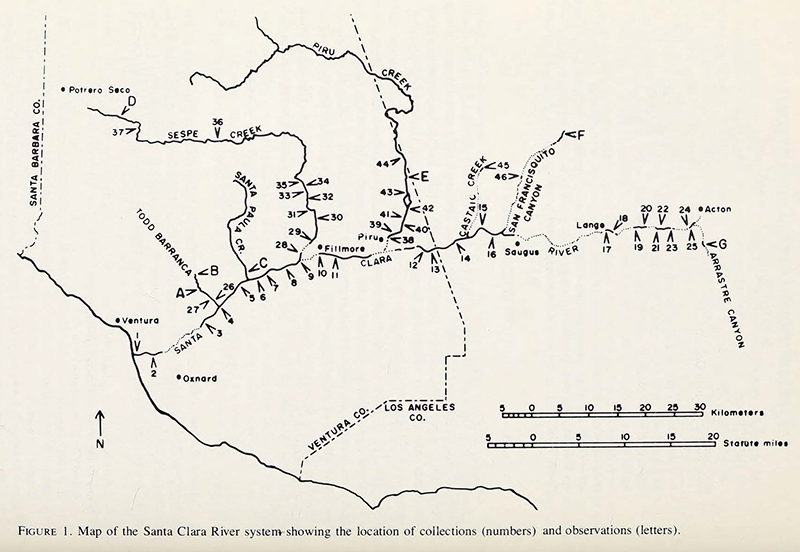Fishes of the Santa Clara River System, Southern California.
|
Webmaster's note. In this oft-cited study, author Michael A. Bell, Ph.D, of Stony Brook University, New York, describes the distribution of fishes within the Santa Clara River and most of its tributaries that were sampled from field observations and 46 fish collections in September 1975. Collections were made in the Santa Clara River, San Francisquito Canyon, Piru Creek, Sespe Creek and Todd Barranca (Ventura County between Santa Paula and Saticoy). Santa Paula Creek and Arrastre Canyon (the headwaters of the Santa Clara River in Acton) were examined briefly. The original purpose of the sampling program was to determine the distribution of threespine stickleback (Gasterosteus aculeatus) phenotypes. The author identifies two subspecies in the area: Gasterosteus aculeatus microcephalus, the "smallhead" threespine stickleback, which has lateral plates (armor) on its anterior parts and is not endangered; and Gasterosteus aculeatus williamsoni, the unarmored threespine stickleback, which is a federally endangered species. The author found varieties of Gasterosteus aculeatus "in every stream where fishes were found except in Arrastre Canyon and Castaic Creek," and they were abundant at all collecting stations "except in the Santa Clara River between Saugus and Piru and in the headwaters of some tributaries." He states that the non-endangered G.a. microcephalus was found in the headwaters of Sespe Creek in Ventura County on the west, while the endangered G.a. williamsoni was found "mostly upstream of Saugus" on the east. He found that various morphs of the two — "intergrades between these two subspecies" — occupied the remainder of the area where Gasterosteus aculeatus was found. The author notes a plan by the U.S. Army Corps of Engineers in 1972 (actually 1968) to channelize a portion of the Santa Clara River and claims it could lead to the extinction of G.a. williamsoni. Citing previous research, he states that G.a. williamsoni was once abundant in the Los Angeles Basin but went extinct there between 1929 and 1942. Previous research attributed its extinction to the introduction of a predatory mosquitofish, but Bell (the author) notes that the same mosquitofish is present in the Santa Clara River study area where stickleback thrive. The author believes the deterioration of surface flow in the L.A. Basin through urban growth and the channelization of rivers "may have been critical." (Note: Congress authorized the channelization of the L.A. and Santa Ana Rivers in 1941, in response to the "Great Flood of 1938." The Army Corps ultimately dropped its plan to channelize the Santa Clara River.) The author collected a total of 15 different fish species, of which five were native and the rest imported. Arroyo chubs (imported) were the most prevalent, followed by the stickleback — native except for San Francisquito Canyon where the author states it "may or may not be native."
Download original pdf here.
|

